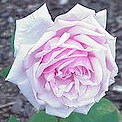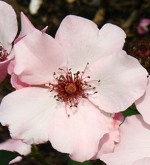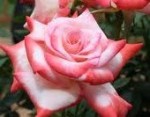Everyone loves roses and why not? They are beautiful flowers, suggest romance, and have been featured in literature and art for over two thousand years. Most of the roses you receive from the florist or see in rose gardens are hybrid teas. They are the most popular rose and more of them are grown than any other kind of rose. Public gardens, private gardens, nurseries, and even big box stores cater to the taste of those who love them. Yet, those same hybrid tea roses that look so good when they are blooming can be ratty looking bushes when out of bloom. So why are people so crazy about hybrid teas? What characteristics make them so appealing?

As the name suggests, hybrid teas are the result of a cross between two old garden roses, a tea rose and a hybrid perpetual rose. The first hybrid tea was probably ‘La France’, created in 1867 by Jean-Baptiste Guillot, a French nurseryman. Its flowers are pink, fragrant, 4” across, and borne on long stems. It repeats well and is still considered a great rose. Its major flaw is its soft petals and leaves that are prone to fungal infections. Hey, you can’t get everything on the first try.
People choose roses for may reasons but most hybrid tea lovers will agree on certain characteristics that they find especially important.
 Flower Size: The flowers are large, usually 4-5” across.
Flower Size: The flowers are large, usually 4-5” across.

 Petals Number: 30 –50 but there are some singles like ‘Dainty Bess’
Petals Number: 30 –50 but there are some singles like ‘Dainty Bess’

 Flower Form: This characteristic refers to the way the petals unfurl and is best appreciated when the roses are ½ to ¾ open. At this stage they will form a triangle when viewed from the side. The unfurled petals should be evenly and symmetrically arranged around a high, pointed, well-defined center with the outer most petals as perpendicular to the vertical center as possible. When the rose is viewed from above the petals should form a perfect spiral from a point in the center. A poorly defined center such as a hole in the center or a center that is hidden by part of a petal is considered a major flaw. A side view of the rose when should form a triangle with the center at the apex. People that show roses are especially attentive to this characteristic.
Flower Form: This characteristic refers to the way the petals unfurl and is best appreciated when the roses are ½ to ¾ open. At this stage they will form a triangle when viewed from the side. The unfurled petals should be evenly and symmetrically arranged around a high, pointed, well-defined center with the outer most petals as perpendicular to the vertical center as possible. When the rose is viewed from above the petals should form a perfect spiral from a point in the center. A poorly defined center such as a hole in the center or a center that is hidden by part of a petal is considered a major flaw. A side view of the rose when should form a triangle with the center at the apex. People that show roses are especially attentive to this characteristic.
 Flower Substance: This is the quality that keeps a rose looking fresh. It is dependent on the amount of moisture held in the leaf and can be felt in the thickness, rigidity, and texture of the petals. Substance is an important factor in determining the ability of the flower maintain its form and withstand rain and wind as well as perform as a cut flower.
Flower Substance: This is the quality that keeps a rose looking fresh. It is dependent on the amount of moisture held in the leaf and can be felt in the thickness, rigidity, and texture of the petals. Substance is an important factor in determining the ability of the flower maintain its form and withstand rain and wind as well as perform as a cut flower.
 Flower Color: The American Rose Society recognizes 18 color classes. Some are more popular than others but color is strictly an individual preference. Red is a favorite among all rose growers and hybrid tea lovers are no exception but there are many pink, yellow, white hybrid teas with a significant number of lavender, orange and blends. So far, no true blue or black roses have been produced.
Flower Color: The American Rose Society recognizes 18 color classes. Some are more popular than others but color is strictly an individual preference. Red is a favorite among all rose growers and hybrid tea lovers are no exception but there are many pink, yellow, white hybrid teas with a significant number of lavender, orange and blends. So far, no true blue or black roses have been produced.
 Fragrance: Most people would like hybrid teas to have fragrance but less that 25% do. Apparently fragrance is not high on the list of important consideration for most hybrid tea growers.
Fragrance: Most people would like hybrid teas to have fragrance but less that 25% do. Apparently fragrance is not high on the list of important consideration for most hybrid tea growers.
 Flowering: Hybrid tea bushes flower abundantly in the spring and repeat periodically the rest of the growing season until fall when they have a second grand flowering that is definitely less that the first flowering in spring.
Flowering: Hybrid tea bushes flower abundantly in the spring and repeat periodically the rest of the growing season until fall when they have a second grand flowering that is definitely less that the first flowering in spring.
 Stem: Good stems are long, straight, and able to hold the flower up. One of the pleasures of growing hybrid teas is their use as cut flowers and strong stems are essential.
Stem: Good stems are long, straight, and able to hold the flower up. One of the pleasures of growing hybrid teas is their use as cut flowers and strong stems are essential.
 Size of Bush: Upright, 3-5’.
Size of Bush: Upright, 3-5’.
 Disease Resistance: Another desirable trait in roses but one that is generally not true of hybrid teas. Some are more disease resistant than others but since hybrid teas are bred for the characteristics of the flowers, good disease resistance is not the rule and most of them must be sprayed to keep disease and insects under control.
Disease Resistance: Another desirable trait in roses but one that is generally not true of hybrid teas. Some are more disease resistant than others but since hybrid teas are bred for the characteristics of the flowers, good disease resistance is not the rule and most of them must be sprayed to keep disease and insects under control.
 Hardiness: Many hybrid teas have to be mulched in cold climates. Check individual cultivars before buying.
Hardiness: Many hybrid teas have to be mulched in cold climates. Check individual cultivars before buying.
 Heat Tolerance: Although hybrid teas grow where summers are hot, long periods of heat can decrease blooming as well as the longevity of the plant.
Heat Tolerance: Although hybrid teas grow where summers are hot, long periods of heat can decrease blooming as well as the longevity of the plant.

-
‘Moonstone’: (Double, white edged with pink, fragrant; great cut flower)
‘Gemini’: (Double, blended shades of coral and cream; mild fragrance, good disease resistance)
‘Veteran’s Honor: (bright red turning to tones of pink; raspberry fragrance; long vase life; disease resistant.)
For a hybrid tea (or any rose) to reach its full potential, it must be grown under optimum conditions. This means that water, fertilizer, light, disease and pest control, pH, and soil quality, have to be carefully controlled to get the desired result. Combine good cultivation with a cultivar that has great potential in its genes and you are on your way to having the hybrid tea of your dreams.
